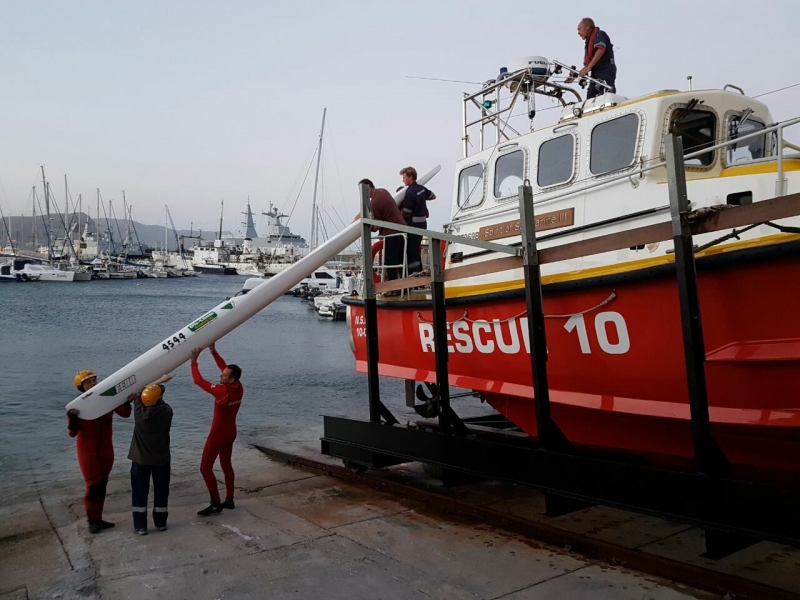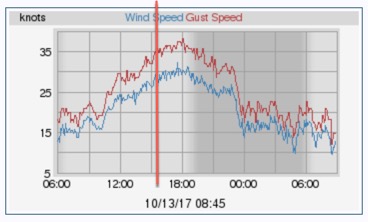Safety Notes – Two Failures of Safety Gear
 The rescued surfski is unloaded from NSRI Station 10's Spirit of Safmarine.
The rescued surfski is unloaded from NSRI Station 10's Spirit of Safmarine.
“We have multiple reports of a surfski washing ashore without the paddler,” said NSRI Simon’s Town Station Commander Darren Zimmerman. “We’re activating. Can you please try to find out who it might be?”
Yesterday saw Cape Town experiencing “proper” Miller’s Run conditions – average 28kt increasing to 30kt over the course of the afteroon and gusting to 38kt. The sea was fairly wild with occasional sets of what felt like enormous swells coming through. The usual short crashing sounds of the breaking waves were interspersed with longer, intimidating rumblings that seemed to go on for ever… and which provoked thoughts of “don’t look back” and “Hmm… I don’t want to be hit by one of those” and “Keep your speed up”. In other words, fabulous conditions. But...
Unfortunately we had two emergencies, both involving gear failure and swimming paddlers over the course of the afternoon. Happily, both ended well, but the gear failures are a concern – hence this article.

Yesterday's wind recorded at Fish Hoek
Failure #1 – Leg leash
The first incident happened at around 3h30pm. A group of paddlers had set off from Miller’s Point and were approaching Fish Hoek when one of them fell off his ski. He remounted, but fell off again – and this time he lost his grip on the ski and it simply blew away from him. Somehow, his leg leash had detached itself.
Estimates vary of the distance of his resulting swim (his estimate is 2-3km; his buddy’s estimate is around 1km!) but he was very cold by the time he climbed out and over the rocks near Glen Cairn.
(Incidentally, he wasn’t on his own. But his buddy, after shepherding him all the way from Miller’s Point, had just caught a run and had gone perhaps 200m further ahead. When he stopped to check on his friend, he could see nothing – not the swimmer, not the surfski. By the time he got to shore and raised the alarm, the swimmer had reached shore.)
And that was when I received the call from the NSRI – just as I was setting out for my own Miller’s Run. A few calls to establish that the paddler was home and dry and NSRI stood down.
But it could have been very different; if it had happened further out to sea, things could have been very much more serious.
We can’t tell why the leash unclipped; it didn’t break, the catch simply came undone. The leash in question has a plastic quick release clip – did this slip? Who knows? What is certain though is that no single piece of safety equipment is infallible. Components can age, can break, can slip, clips can be fastened incorrectly.
When you use a leash:
- Make sure it’s properly clipped on.
- Replace it regularly - every 1-2 years. After your PFD, it’s your primary safety device.
- Consider using a paddle leash as well. If your primary leash detaches or breaks, the paddle leash might save you.
- Give some thought to what you’d do if you did lose your boat. What distance can you swim? Have you a means of calling for help like a mobile or VHF radio on your person (as opposed to on the boat)? How would you tell anyone your position?
Failure #2 – PLB
The second incident of the afternoon occurred later when a second group did the Miller’s Run. (My buddy and I set off about ten minutes after this lot, and we never saw any of them. Shortly after the start, I was hit side-on by a wave and took a brief swim. Aside from that, the run was glorious.)
The paddler in question had had his boat damaged when the wind knocked it against the trailer and had borrowed a ski to do the run. It wasn’t set up quite the same as his boat and he was uncomfortable and eventually fell off and was unable to remount.
He had a PLB with him – which he activated. He then swam for an hour and half towards Simon’s Town.
The alarm was raised by the Miller’s Run taxi who’d noticed that he was overdue, and the NSRI activated.
No alert came from the PLB system.
By the time the NSRI launched, he’d already arrived within 100m or so of the Simon’s Town harbour wall. They picked him up and took him to the base where he was treated for mild hypothermia and released unharmed…

The paddler's track - swimming from just after km 4
What happened with the PLB?
The PLB company has been contacted and are conducting an investigation to find out why the alarm wasn’t raised. It’s far too soon to speculate on the reasons, but we will feedback their findings. But whether it was user error or system failure or communication failure, the point again is that no one system is a silver bullet.
In this case the paddler had his leash and his PFD and his fitness which enabled him to swim most of the way to safety. Hats off to him.
Use SafeTRX!
A system worth considering is the SafeTRX app, which is integrated directly into NSRI’s communication systems. The Maritime Rescue Coordination Centre in South Africa (MRCC) receives alerts from SafeTRX and inform NSRI. NSRI has immediate access to the SafeTRX data, which includes the user’s GPS position.
In this case, had the paddler used the app in “Sail Plan” mode, his overdue status would have automatically alerted the rescue services – and he could also have triggered the alert himself. NSRI would have known exactly where he was and he’d have been out of the water a lot sooner.
NSRI (and I!) strongly recommend SafeTRX RSA for South African paddlers. SafeTRX is available in many parts of the world including most of Europe and Australia.

